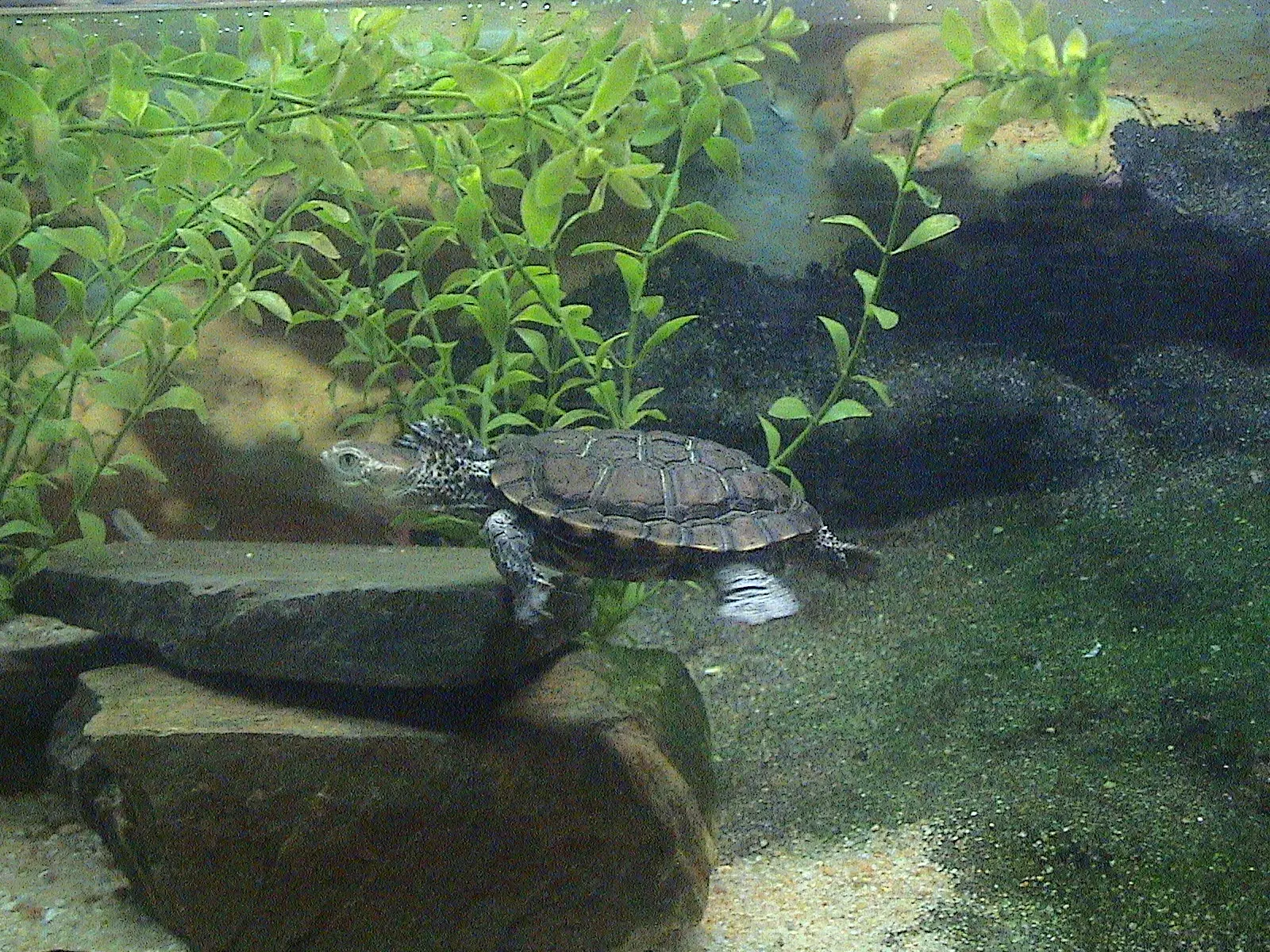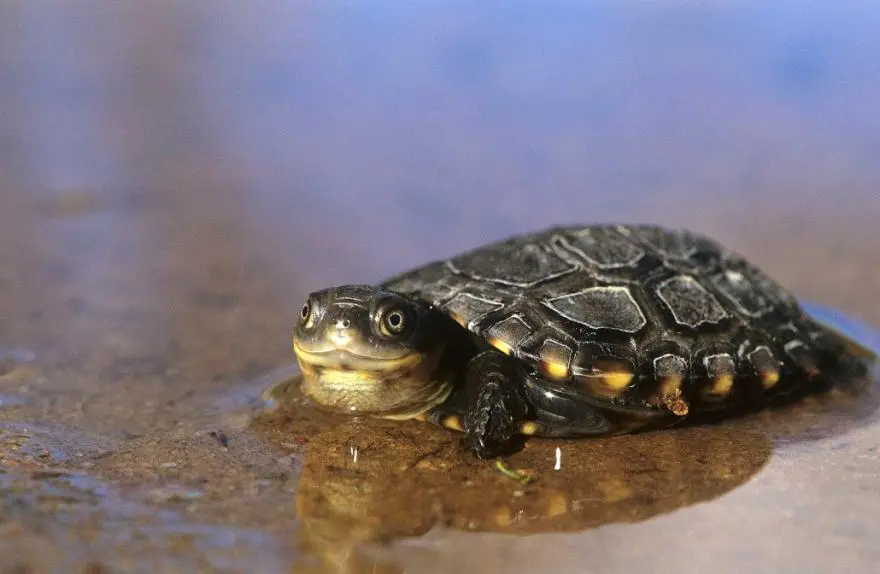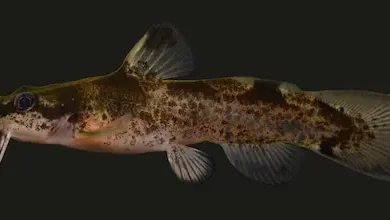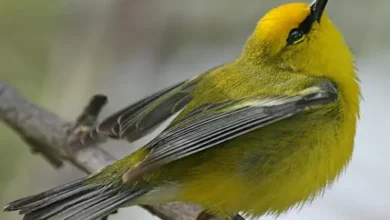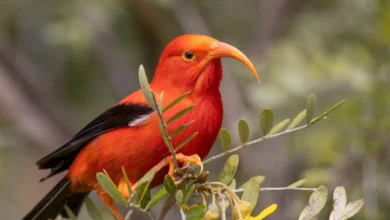Western Swamp Tortoise (Pseudemydura umbrina): Australia’s Rarest Reptile Facing Extinction
1. Introduction & Taxonomy
The Western Swamp Tortoise, also referred to as the Western Swamp Turtle, Pseudemydura umbrina, is a critically endangered freshwater reptile endemic to Western Australia. It is the only living species within its genus (Pseudemydura) and the sole member of the subfamily Pseudemydurinae within the family Chelidae zoossa.com.au+9Wikipedia+9DCCEEW+9.
First described scientifically by Siebenrock in 1901, the Western Swamp Tortoise was initially based on a lone specimen collected in 1839 in southwestern Australia. Believed extinct until a schoolboy rediscovered it on a Perth road in 1953, the species was briefly named Emydura inspectata before its synonymy with P. umbrina was confirmed angfaqld.org.au+3Wikipedia+3DCCEEW+3.
Phylogenetically, P. umbrina is distinct from other Australian freshwater turtles and has been isolated for millions of years, with fossil evidence from early Miocene deposits closely matching modern individuals, indicating incredible evolutionary stability DCCEEWWikipedia.
2. Physical Description
2.1 Size & Sexual Dimorphism
-
Adults: Males reach up to ~155 mm carapace length (~15.5 cm) weighing as much as ~550 g; females generally smaller at ~135 mm (~13.5 cm) and ~410 g angfaqld.org.au+9DCCEEW+9Healthy Rivers+9.
-
Hatchlings: Begin life at only ~24–29 mm in length (2.4–2.9 cm), weighing between ~3.2 and 6.6 g Wikipedia+11DCCEEW+11Healthy Rivers+11.
2.2 Shell & Skin Features
-
The carapace is broadly rectangular and domed, with coloration that varies from yellow-brown in clay-based wetlands to nearly black or maroon-tinged in darker “coffee-coloured” swamps DCCEEW+1Wikipedia+1.
-
The plastron (bottom shell) ranges from pale yellow to brown or black, often edged in black or bearing black spots The Turtle Hub+2DCCEEW+2Wikipedia+2.
-
The skin on the neck features horn‑covered tubercles; the head sports a single large scute and two small barbels. Limbs are short and scaly, with webbed toes, each bearing five claws Wikipedia+4DCCEEW+4perthzoo.wa.gov.au+4.
2.3 Unique Traits
-
It is the smallest chelid turtle in Australia.
-
Females uniquely dig nests with forelimbs, unlike all other turtles, which use hind limbs westernswamptortoise.com.au+10Healthy Rivers+10DCCEEW+10angfaqld.org.au.
-
Sexual dimorphism is evident: males are larger, have longer tails, and more concave plastrons to facilitate mating The Turtle Hub.
3. Distribution & Habitat
3.1 Historical and Current Range
Historically, the Western Swamp Tortoise occupied ephemeral wetlands across the Swan Coastal Plain in southwestern WA. However, widespread urbanisation, agriculture, and land clearing have critically restricted its range to a mere ~100–150 km² zoossa.com.au+11DCCEEW+11Healthy Rivers+11.
Today, only one naturally recruiting population at Ellen Brook Nature Reserve, along with two translocated populations at Twin Swamps and Mogumber Nature Reserves, sustain the species in the wild angfaqld.org.au+3DCCEEW+3DCCEEW+3.
3.2 Habitat Specificity
This tortoise strictly requires shallow, ephemeral, winter‑wet swamps on clay or clay-over-sand soils. Habitat must include adjacent refuges — such as deep leaf litter, natural ground holes, fallen timber, or man-made tunnels — to allow aestivation (summer dormancy) when swamps dry DCCEEW+11Healthy Rivers+11DCCEEW+11.
4. Behaviour & Life Cycle
4.1 Seasonal Activity & Aestivation
-
Winter–Spring (June–September): Swamps fill with rainfall, enabling the tortoises to emerge from aestivation, swim, feed, and grow. A hydroperiod of about 6–7 months is optimal; shorter wet seasons lead to stress and low reproductive output in females westernswamptortoise.com.au+1angfaqld.org.au+1.
-
Late Spring–Early Summer (September–November): As water levels recede, tortoises journey to dry refuges and enter aestivation, sometimes in underground burrows or litter layers. This dormancy protects them from heat and fires during the hottest months Western Australian MuseumWikipedia.
4.2 Diet & Feeding Behaviour
A fully carnivorous predator, P. umbrina eats only live prey. Its diet includes:
-
Aquatic crustaceans (e.g. Eulimnadia)
-
Insect larvae from beetles (Coleoptera) and flies (Diptera)
-
Tadpoles and small aquatic worms including Eodrilus spp. Wikipedia+11CSIRO Publishing+11angfaqld.org.au+11.
Captive specimens may refuse food unless starved, underscoring their strict dietary preferences CSIRO Publishing.
4.3 Reproduction & Growth
-
Sexual maturity is reached at 10–15 years, due to slow growth.
-
Females lay a single clutch per year (typically 3–6 eggs) in November–December, placing nests in the edges of drying swamps using forelimbs to dig angfaqld.org.au+3Healthy Rivers+3DCCEEW+3.
-
Egg incubation takes ~6 months, with hatchlings emerging in May–June near the onset of rain, often the size of a ten‑cent coin (2.5 cm) Western Australian Museum+2Western Australian Museum+2westernswamptortoise.com.au+2.
-
Survivorship is low due to predation in early life stages and highly specific ecological requirements. Lifespan in ideal conditions can reach 60–70 years angfaqld.org.auWestern Australian Museum.
5. Population Status & Threats
5.1 Population Trends
-
In the 1960s, more than 250 mature individuals were estimated to exist. By the 1980s, that number had plummeted to fewer than 50 wild adults angfaqld.org.au.
-
As of the 2020s, estimates suggest 15–25 mature individuals in the wild, and roughly 400–500 individuals including captive and translocated ones DCCEEWWestern Australian Museum.
-
While captive breeding has produced over 1,300 turtles since 1988 (with 1,125 released), wild recruitment remains limited and vulnerable perthzoo.wa.gov.auangfaqld.org.au.
5.2 Primary Threats
-
Habitat Loss & Alteration: Agricultural clearing, urban expansion, swamp drainage and clay extraction have destroyed or fragmented most suitable habitat WikipediaDCCEEW.
-
Climate Change & Hydrological Shifts: Reduced winter-spring rainfall and groundwater extraction have shortened hydroperiods, limiting feeding and reproduction windows angfaqld.org.auDCCEEW.
-
Predation: Introduced predators—particularly the European red fox, as well as feral pigs, ravens, bandicoots and native birds—consume both hatchlings and eggs Wikipedia+10Healthy Rivers+10Western Australian Museum+10.
-
Fire & Disturbance: Inappropriate fire regimes can destroy aestivation refuges or kill aestivating individuals, especially if burns occur in summer/autumn DCCEEW+7DCCEEW+7DCCEEW+7.
-
Genetic Bottlenecks: Small, fragmented populations limit genetic diversity, increasing risks of inbreeding depression DCCEEW+1Wikipedia+1.
6. Conservation & Recovery Efforts
6.1 Recovery Plans & Coordination
Australian and Western Australian governments rank it as Critically Endangered under federal EPBC Act and state legislation, and it is listed on the IUCN Red List and CITES Appendix I DCCEEW+1Western Australian Museum+1.
A comprehensive Recovery Plan (2004, updated 2010) established clear goals: increase wild mature numbers to > 50 across at least three self-sustaining populations, maintain captive breeding, and initiate translocations to new sites DCCEEW+1angfaqld.org.au+1.
6.2 Captive Breeding & Releases
-
Perth Zoo began breeding the tortoise in 1988. By mid-2024, over 1,300 tortoises had been successfully reared, with more than 1,100 individuals released into secure wild sites perthzoo.wa.gov.au+1angfaqld.org.au+1.
-
The captive program maintains ~12 breeding pairs, producing a steady annual cohort of juveniles intended for release into natural and translocated habitats DCCEEWDCCEEW.
6.3 Translocation & Habitat Management
-
Releases have occurred at Twin Swamps, Mogumber, and—to a planned extent—Moore River Nature Reserve, with site selection informed by habitat suitability and climate resilience DCCEEW+1DCCEEW+1.
-
Fenced reserves and fox control baiting, along with water management (e.g. bore pumping), help maintain suitable hydroperiods and reduce predation risk angfaqld.org.au.
6.4 Fire & Refuge Protection
Management protocols now emphasize planned burns outside aestivation periods, protection of litter refuges, and minimal disturbance to aestivating tortoises, especially in captivity where early cages disturbed natural cycles and caused weight loss and fatalities DCCEEW.
6.5 Community Engagement & Research
Organizations like The Friends of the Western Swamp Tortoise help raise awareness, support conservation, and engage volunteers for monitoring and captive programs Wikipedia+10Western Australian Museum+10Western Australian Museum+10.
Ongoing scientific research covers population genetics, thermal ecology, nesting success, mortality rates, and modeling for assisted colonisation in cooler habitats further south to buffer impact of climate warming angfaqld.org.auWikipedia.
7. Ecology & Environmental Role
7.1 Ecological Niche
-
P. umbrina occupies a narrow ecological niche: temporary clay‑bottom wetlands with seasonal water availability.
-
Its lifecycle—including aestivation, precise soil and water temperature thresholds, and carnivorous feeding—is finely tuned to winter–spring hydroperiod cycles Wikipedia+11Healthy Rivers+11Healthy Rivers+11westernswamptortoise.com.au.
7.2 Trophic Interactions
-
As a consumer of aquatic invertebrates and amphibian larvae, the tortoise contributes to wetland ecosystem balance.
-
Its eggs and juveniles form part of food webs involving foxes, bandicoots, and wading birds, reinforcing the need for predator control in conservation areas.
7.3 Evolutionary Importance
-
Representing a lineage with minimal divergence since the Miocene, P. umbrina provides scientific insight into early freshwater turtle evolution in Gondwanan‑derived landscapes CSIRO PublishingDCCEEW+1Wikipedia+1.
8. Future Outlook & Challenges
8.1 Climate Change Resilience
-
Continued decline in winter rainfall poses severe risk by truly shortening hydroperiods necessary for growth and reproduction.
-
Assisted colonisation, translocating tortoise populations into cooler southern swamps with longer water retention, is under consideration—and has precedent in other conservation translocations angfaqld.org.auWikipedia.
8.2 Long-Term Population Viability
Future success hinges on:
-
Sustaining multiple, geographically separated wild populations with natural recruitment.
-
Improving genetic diversity to avoid inbreeding depression.
-
Ensuring habitat management continues in the face of urban development, fire regimes, and changing hydrology.
8.3 Research & Adaptive Management
Key gaps include:
-
Refining incubation/soil-temperature thresholds for egg survival (ideally < 34 °C).
-
Monitoring post-release survival, growth, and breeding success.
-
Evaluating viability and ecological impacts of novel localities and climate refugia.
9. Why It Matters
The Western Swamp Tortoise exemplifies the plight and promise of modern conservation:
-
It is Australia’s rarest reptile, categorized among the most endangered turtles globally.
-
Despite tiny population size and highly specialized habitat needs, captive breeding, targeted translocations, and community efforts have already prevented extinction Healthy Rivers+1Healthy Rivers+1DCCEEW+6Western Australian Museum+6Healthy Rivers+6.
-
The species highlights the value of wetland ecosystems, the impacts of climate change and habitat fragmentation, and the potential for climate‑informed translocation as a conservation tool.
10. Summary Table
| Feature | Details |
|---|---|
| Scientific Name | Pseudemydura umbrina |
| Family/Subfamily | Chelidae / Pseudemydurinae (monotypic) |
| Size | Male ~155 mm, Female ~135 mm |
| Weight | ~550 g (male), ~410 g (female), ~3–6 g (hatchlings) |
| Habitat | Seasonal swamps on clay soils with refuges nearby |
| Distribution | Swan Coastal Plain, WA; ~100–150 km² total |
| Diet | Carnivorous—only live prey (invertebrates, tadpoles) |
| Reproduction | One clutch/year of 3–6 eggs; maturity at ~10–15 yrs |
| Lifecycle | Active winter–spring; aestivates summer to autumn |
| Longevity | Up to 60–70 years under ideal conditions |
| Population | ~15–25 wild adults; ~400–500 total including captive/translocated |
| Conservation Status | Critically Endangered (IUCN, EPBC Act, WA Biodiversity Act) |
| Threats | Habitat loss, drought, predation, fire, low genetic diversity |
| Conservation Actions | Captive breeding, habitat management, translocation, predator control |
11. Conclusion
The Western Swamp Tortoise, Pseudemydura umbrina, is a critically endangered relic with an exceedingly restricted distribution and stringent ecological requirements. With only a few dozen mature individuals left in the wild, its future rests on continued captive breeding, strategic translocations, coordinated habitat and climate management, and public support.
Yet the story of its rediscovery, rescue, and careful assisted recovery makes it one of the most remarkable conservation success narratives in Australia—and its ongoing survival offers hope and lessons for protecting the world’s rarest species in the face of global change.
References
-
Recovery planning and species profiles: DCCEEW / Perth Zoo / Threatened Species Recovery Hub angfaqld.org.au+11DCCEEW+11Wikipedia+11Healthy Rivers+2DCCEEW+2DCCEEW+2Wikipedia+3Healthy Rivers+3DCCEEW+3perthzoo.wa.gov.au+1Western Australian Museum+1angfaqld.org.au+2DCCEEW+2Healthy Rivers+2Western Australian Museum+1Western Australian Museum+1angfaqld.org.au
-
Ecology and life history details: Burbidge (1981), CSIRO; ANGFA QLD; Western Australian Museum CSIRO Publishing+1angfaqld.org.au+1
-
General description and taxonomy: Wikipedia; TurtleHub Wikipedia+1The Turtle Hub+1

